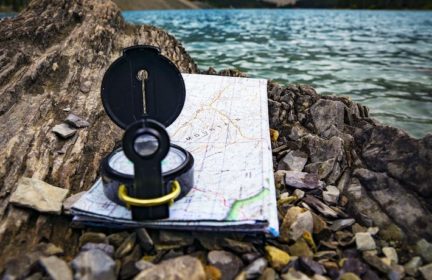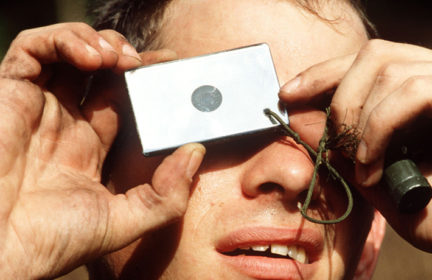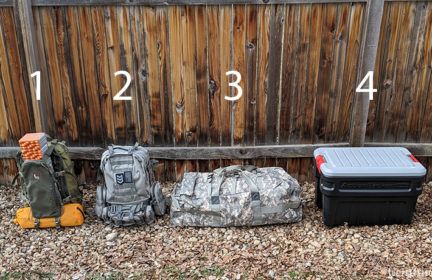BOB plus Get Home Bag?
First, I would like to say what an impressive site this is. I have never joined any forums; but wanted to, in part, to thank you for the very clear, factual and thorough information!
My question is about the Get Home Bag. Is it best to create a duplicate of your main BOB? I am taking an inventory of my BOB, and with the help of this site, working on upgrading it. Should I create two bags exactly the same–one for home and one for away? Or, is the Get Home Bag typically a smaller kit?
Thank you for any advice!
-
Comments (15)
-
MrsG - July 22, 2020
I’m currently working on this myself so putting out there I’m no kind of expert. But what I’ve decided to do is having the Get Home Bag be a smaller version of the BOB. I also have one Get Home Bag per vehicle whereas the BOB’s are individual for our 4 family members. I’m also thinking of the BOB”s as possible use if we are bugging in (earthquake country for one so you never know). I am in the process of assembling, still overwhelmed, but trying my best.
-
Pat - July 22, 2020
Thank you for your reply, MrsG!
-
Lowell - April 24, 2021
@MrsG that’s interesting about GHB per vehicle rather than per person! Would you please walk me through your thinking here? This seems like a fantastic way to save space, but it also assumes that your “party” is able to stick together, right?
-
MrsG - April 24, 2021
Hi there. The Get Home backs are smaller and stay in the cars—there are times my husband is driving one car and I’m driving another. Sometimes into the mountains. So I want the “get home” bag in there incase we get stuck or something happens.
The Bug Outs are slightly more extensive and stay by the front door for the four of us if we had to bug out by vehicle or on foot. Then I figure if we went in the car the bags in there would just be extra in case we wanted to help someone etc.
-
-
JB - July 23, 2020
My approach has been to make my get home bag as close to my BOB as I can, though I had more money when I was making my first bag. I’m working from home now, so I’m usually close to my BOB so I’m okay with it taking longer to make the 2nd one. I might cut a few corners because not everything I want is available right now anyway.
-
Rich DCContributor - July 23, 2020
Try not to overthink the labels. This site suggests a tiered bag system and I’m a fan of that mentality. To be honest, I do have secondary BOB’s but they’re at home because there are two people in my household. I also have an every day carry that is TSA-proof (no sharp objects, nothing that would get flagged at a security check point), and a medium sized/light kit that is a step up from my every day carry but not as hardy as a BOB, still has a decent first aide kit but less food, water, and fire starting options. No extra clothes, either. I also have a heavy duffel thats really only approbate for carting to a car, so your tiered bags can both scale up and down.
-
Josh CentersContributor - July 24, 2020
My strategy with the ILBE system (see my review here) is to use the smaller Assault Pack as a light-duty get-home bag when detached from the main pack. There’s a lot of downsides to the ILBE, but I appreciate the modularity. So when I get ready to leave the house (not often these days), I detached the Assault Pack and toss it in the car.
Here’s my kit (I need to update it to add my new electronics kit). I hope it gives you some ideas:
-
Matt Black - July 27, 2020
Short answer: Yes, two separate bags.
Longer answer:
I used to travel a lot for work -way back in the ‘before times’ when I hadn’t been laid off because of a certain pandemic. When I was on the road, I had a Get Home bag [GHB]. Its sole purpose was to hold those things necessary for me to get home. No bells, no whistles, no frills, just something to sling over my shoulder while I made my way home. Since I was rarely more than a day’s walk away from home at any given time, my GHB was what one might consider a minimalist’s GO bag: powerbars/rations, water, some cash, knife, and a few other sundries. This, was in addition to the first aid kit and roadside breakdown kits I’ve always had in my truck. So, I always had the option of cannibalizing from those kits. If it helps, you can think of a GHB in terms of being something like [in my case] a single day version of a GO bag.
One of the most important preps to have at the ready is your mindset. It’s critical to be flexible in thinking and to be vigilant against self-accomplishment. Nothing is static and eternal. In practical terms, update gear whenever you can (financially, of course) and pack gear for the conditions (eg., seasonal, sociological, and political changes).
The current iteration of my GO bag provides for nearly 7 days (up from 3 days given recent events) of being away before I have to resort to fishing, hunting, and foraging.
And because one can never truly predict how long a GO situation might potentially last [remember, be flexible!], I have a simple, 3-level, priority system for supplementing my GO and it is for now (unless others have better suggestions), based on the following conditions:
- lead time – the amount of head’s up time we have
- degree and magnitude of the threat/event – contingent on information availability/threat assessment
- door time – how much time I have alloted my household to be out the door
- potential duration – dependent upon the degree and magnitude of the threat/event
Priority 1: Incoming danger. 0-5 mins lead time. Door time: ASAP. Grab GO bag, docs, meds, defensive gear
Priority 2: Imminent danger. 0-10 mins lead time. Door time: 15-20 mins. Grab GO, docs, meds, defense, extras
Priority 3: Possible danger. 0-30 mins lead time. Door time: up to 60 mins. Grab GO, docs, meds, defense, extras, and extra-extras. -
LNMOt - April 25, 2021
Great post and question – I am working on putting together my get home bag, it will probably take months to save up and purchase all of the gear but I feel great to have gotten that process started after a long time of thinking, planning and getting the final list together.
I relied heavily on The Prepared lengthy and detailed guide / article talking about bug out bags – that is a great place to start and tailor from there. I agree though, it would be great to have a detailed guide / article on get home bags.
I am by no means an expert, so I’ll just share my thoughts and approach. I plan on going on an overnight hike by myself sometime this summer once my bag is fully together to test my pack list and hopefully identify any critical missing items.
Basically I think there is at least a 95% cross over between a get home bag and a bug out bag. Instead of making myself a get home bag AND having a bug out bag (containing 95% of the same things) at my house, I am going to create a small “addendum” pouch that will contain a few extra days worth of clean clothes, a mental hygiene item (like a pack of cards), a small luggage lock, etc. So if it’s a bug out scenario I grab that addendum bug out pouch and my get home bag and I’m all set.
I think this idea works for me in particular because I have a long commute to work each way, and I live in northern New England which has quite extreme winters. That combined means it could take me 2-3 days to get home, longer if I had to avoid highways and roads and hike through deep snow in the woods. Therefore my get home bag has to be pretty robust, especially in the winter.
My husband thinks the entire concept is nuts so he refuses to let me make him or carry a get home bag. However, I am going to make him a bug out bag, as well as bug out bags for my two small children that I will keep in our house in case it’s needed.
Just as time consuming and difficult as determining what you are going to have inside your get home bag, is determining what brand, make / model of each item you’re going to put in your bag. The Prepared has great gear reviews that I have used. I also look at Outdoor Gear Lab, as I used them a lot when making expensive rock climbing and ice climbing gear purchases in the past.
Another thing to be aware of – REI has a “used gear” section for gear that is returned. I would NEVER buy used rock or ice climbing gear, like ropes, harness, belay devices, etc. But backpacks, hiking shoes, tents, winter jackets, hiking pants, sleeping bags, etc that have been lightly or even never used is great, in my opinion. Especially because you hope you never have to use the stuff in your get home bag or bug out bag. But you have it there if needed.
For example – I researched which backpack I wanted for my get home bag and landed on the Women’s Osprey Fairview Trek 55. I checked the REI website for used options and found one in basically “new” condition that was about $75 cheaper than if I had brought it new. REI also offered returns on the used items you purchase, so if you get it and think there’s a problem with the product or you don’t like it you can return it no problem.
-
Bob - April 25, 2021
Good afternoon LNMOt,
Ref the mentioned pack of cards, just for info, there are playing cards with opposite side of each having a survival point.
For example: https://www.skilledsurvival.com/best-survival-playing-cards/
Link tells of this company’s product. There are decks of survival cards with different themes, eg wilderness, urban, wild foods principles, …
I’m not recommending above company. There are many in marketplace. Am just pushing idea of multi-functional items.
……
Re the pending overnight hike – alone – do mention to a couple of people and leave with them written material of your plans, route, other specifics.
-
LNMOt - April 25, 2021
Thanks Bob! These cards are fantastic and definitely when it comes to managing weight and survival, it’s great to have a prep that kills two birds with one stone 🙂
As usual, sage advice on making sure I leave detailed route info and plans with my husband before heading out on the overnight hike.
-
Lowell - April 25, 2021
For an overnighter, consider investing in a PLB in case you are without cell service and need to summon medics.
-
-
Kay - January 2, 2022
I appreciate this thread, as it’s something I’ve been struggling to wrap my mind around also of late.
We work from home and we’re aiming to walk/bike more and use the car less when we do leave the house, so that could be a blend of EDC/GHB depending on how we leave. Also on my mind is that where we live we’ve had 2 localized events in an 8-year span (epic flooding + urban wildfire) when people suddenly and unexpectedly could not get back to their homes while at work or running errands, so I’m feeling less use for specific-use differentiation.
My husband and I often wear an ordinary backpack/daypack while out already (I’d at least have a purse in most situations). I’m shifting to centering the high priority items on the bags we already usually use, and adding gym/duffel bags for lower priority items we could toss in the trunk when traveling by car but could wear slung in front while wearing the backpacks if it came to that. This would involve making good use of small organizing bags to shift things as seems appropriate when leaving home for routine reasons. I think it will work if it’s easy enough to grab both in one go out the door. This would be emergency blanket/ultralight tarp level bulk, not tossing sleeping bags and tents in the car for a trek to Costco.
I’ve read elsewhere on this forum about people loading their empty luggage with extras ready for something along the lines of a pre-evacuation alert scenario when you have more lead time to load up a car, and I like this idea as well. It uses what we already have and expands on the priority-focus.
The last reason I think moving to one overall system and making decisions on what to take on the way out will be a good everyday practice for us is that there’s an element of “set it and forget it” in having the stuff sit in the car. It was a godsend with young kids and just getting out the door, don’t get me wrong. However, now that the kids are older, I think the intentionality of what to take each time will offer better modeling and life practice. For example, once our younger, more inexperienced selves drove up to the mountains in summer clothing and were surprised by snow at the trailhead; I felt like a genius for having extra layers in the trunk in a generalized “just in case.” Having that stuff allowed us to skip taking the time to consider where we were going, so we weren’t prepared in a sense I want to develop better for myself and my kids.
-
Gideon ParkerStaff - January 2, 2022
I like the point you make about preloading the car and being ready if you sense that an evacuation is coming. Very proactive and smart idea.
Here’s an additional article that might be helpful for you to read Why you should use a priority bag system and ignore BOB vs. INCH
-
Kay - January 4, 2022
Yes, this is pretty much exactly where I’m going! I probably read this back when it was first published and it stewed in my subconscious… at the time we were dealing with the death of a parent, so I don’t think I really took it in. Like a lot of people, we’ve been more focused on the sheltering in place aspects of preparedness for the last couple years.
However, recent events have understandably rattled the whole community into New Year’s resolutions like completing home inventories and assembling go-bags, which led me into reevaluating our own away-from-home supplies and systems. Feeling scattered, I decided to start again from the beginner’s checklist; when I searched for something along the lines of combined BOB + GHB, I found this forum post but somehow missed that article, so thank you for sharing it.
It’s really interesting (and applicable) to me how the first 3 bags are backpacks, even with this example being for a single individual. I have often ended up also carrying my youngest child’s backpack in front on hikes, but it’s not typically heavy nor bulky like the bags pictured. I will have to experiment… Years ago I got an Osprey Sirrus 24 to help prevent me from overpacking on my children’s behalf and wrenching my own back in the process. I love it and go for it whenever I want more than a purse, but it has a rigid back and therefore I’d be considering it my #1 pack. Expanding on that capacity into a “full BOB” may not be 100% possible carry-wise but more deeply embracing the priority mindset allows for letting go of being a “list completist” yet still feeling reasonably prepared for most situations.
-
-
- News for the Week 2025-12-22 - 1 day ago
- News for the Week 2025-12-15 - 1 week ago
- News for the Week 2025-12-08 - 2 weeks ago
- Building a ‘hospital bag’ - 3 weeks ago
- News for the Week 2025-12-01 - 3 weeks ago
This forum is heavily moderated to keep things valuable to as many people as possible. Full community policies are here. The basics:
- 1. Be nice to each other.
- 2. Stay focused on prepping.
- 3. Avoid politics, religion, and other arguments.
- 4. No unfounded conspiracies, fake news, etc.
- 5. Debate ideas, not people.




